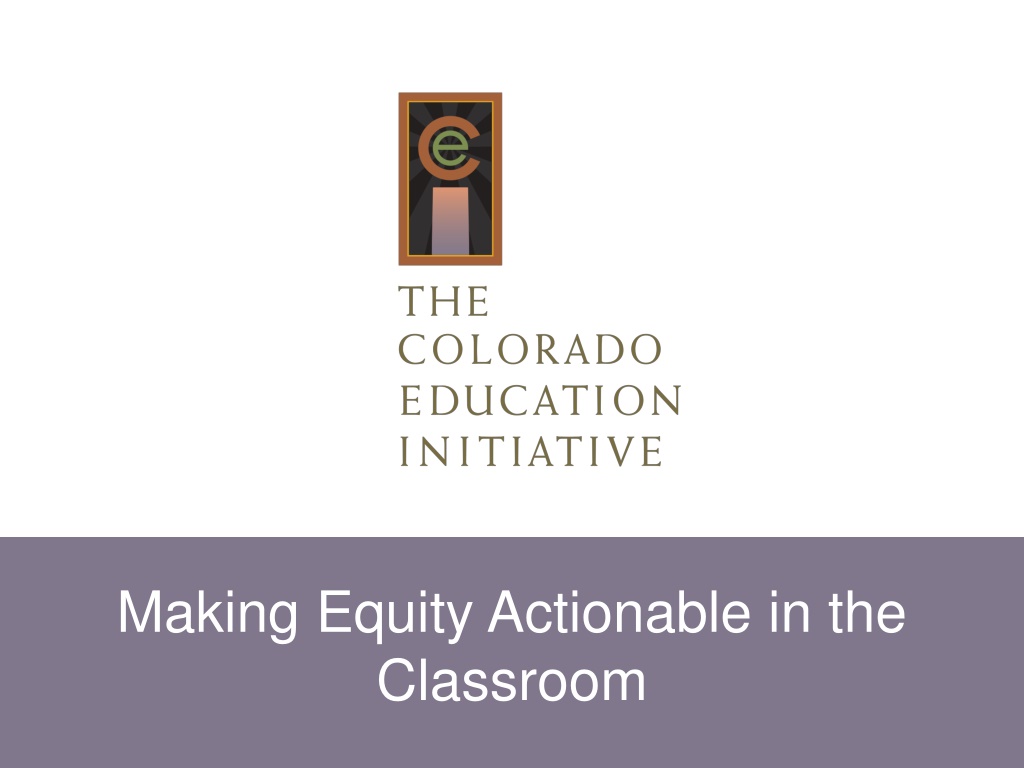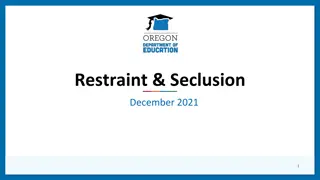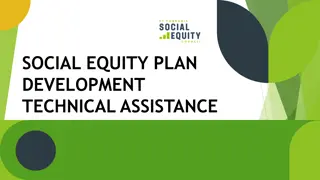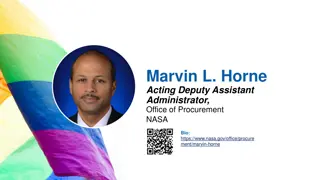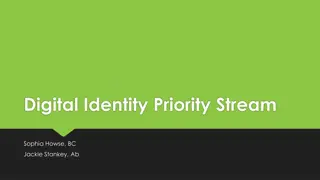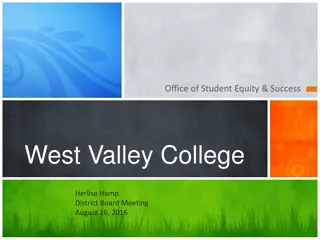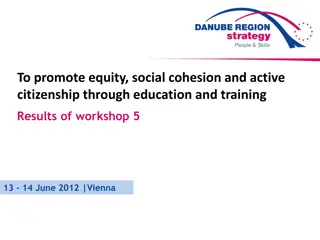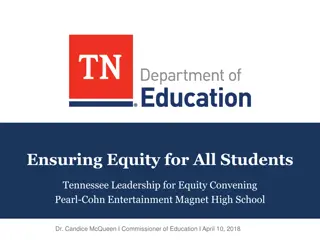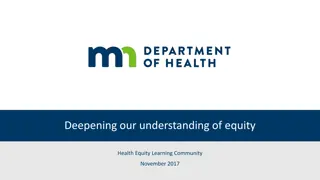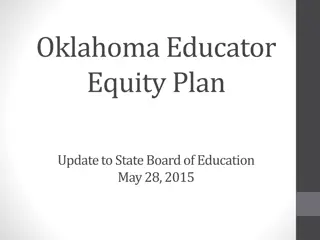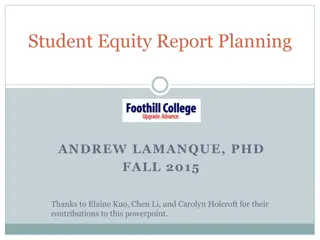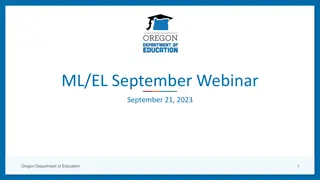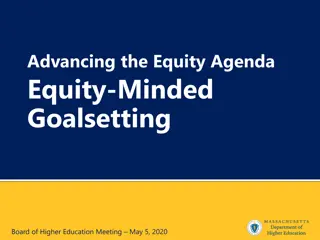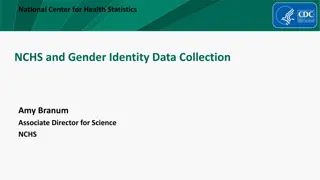Identity and Equity in Education
Exploring the impact of personal identity on student success, the importance of educational equity, and the significance of student and educator identities within the learning partnership. The content delves into constructs like motivation, self-knowledge, self-direction, and relationships that contribute to student success, as well as the concept of providing each child with what they need to reach their full academic and social potential. Additionally, it highlights the necessity of bridging identities between students and educators for effective rapport and cultural understanding.
Download Presentation

Please find below an Image/Link to download the presentation.
The content on the website is provided AS IS for your information and personal use only. It may not be sold, licensed, or shared on other websites without obtaining consent from the author.If you encounter any issues during the download, it is possible that the publisher has removed the file from their server.
You are allowed to download the files provided on this website for personal or commercial use, subject to the condition that they are used lawfully. All files are the property of their respective owners.
The content on the website is provided AS IS for your information and personal use only. It may not be sold, licensed, or shared on other websites without obtaining consent from the author.
E N D
Presentation Transcript
Making Equity Actionable in the Classroom
Student Success Four constructs that explicitly link to student success: (a) motivation, the forces that compel action and direct the behavior of individuals; (b) self-knowledge, the understanding that people have about their own abilities, values, preferences and skills and a necessary precondition for effective self-regulation; (c) self-direction, being able to identify one s own life directions, to make academic choices consistent with these directions and to connect classroom learning to life goals; and (d) relationships, the ability to establish and maintain productive, collaborative, social relationships with teachers and peers. Squier, K. L., Nailor, P, & Carey, J.C. (2014). Achieving excellence in school counseling through motivation, self- direction, self-knowledge, and relationships. Thousand Oaks, CA: Corwin Heart-Mind Connection
How Might Identity Impact Success? Personal identity is the concept you develop about yourself that evolves over the course of your life. This may include aspects of your life that you have no control over, such as where you grew up or the color of your skin, as well as choices you make in life, such as how you spend your time and what you believe. You demonstrate portions of your personal identity outwardly through what you wear and how you interact with other people. You may also keep some elements your of personal identity to yourself, even when these parts of yourself are very important. Heart-Mind Connection
Educational Equity Each child receives what he or she needs to develop to his or her full academic and social potential Title/Date Footer Info
Unpacking Educational Equity Are student needs the same? .to develop . Academic potential? Social potential? Title/Date Footer Info
Learning Partnership: Identity STUDENT IDENTITY How Student sees her/himself in the world Culture, race, gender, class, sexual identity, language, etc. Situatedness (how one is positioned relative to opportunity Identity with peers within school EDUCATOR IDENTITY How Educator sees her/himself in the world Culture, race, gender, class, sexual identity, language, etc. Situatedness (how one is positioned relative to opportunity Professional identity; collegial and pedagogical identity within school, relative to peers IDENTITY BRIDGE How might this Student experience me, given my identity? How can I build rapport and cultural sync with this Student? Looking OUT: What do I understand about my Student s identity in the world? Looking IN: What do I understand about my own identity and situatedness and how others might experience me because of this? Title/Date Footer Info
Learning Partnership: Mindset STUDENT MINDSET Student s beliefs about own learning and capacity Belonging in the academic community Belief that effort leads to increased ability Belief that success is possible Belief that the work has value EDUCATOR MINDSET Educator s belief in own ability to help struggling Students succeed Educator s assumptions about Student s ability to succeed Implicit/Unconscious Bias: unconscious attitudes or beliefs that conflict with intentions MINDSET BRIDGE What mindset do I have about this Student s ability to reach success? Looking OUT: What do I understand about this Student s mindset relative to this subject, to school, to learning Looking IN: What is my own mindset about my ability to support Students toward successful learning? Title/Date Footer Info
Learning Partnership The key to the Learning Partnership is for both Student and Educator to move from unaware/unconscious to aware/conscious Title/Date Footer Info
From Awareness to Action What changes in the classroom? 1. Engagement strategies 2. Instructional strategies 3. Relationships 4. Storytelling Title/Date Footer Info
The narrative matters A narrative is just a story the story of society, of you, of your student(s) Master Narrative: The story that explains the way things are, the way people are, defined by the dominant normative culture about other cultural identities or attributes Asian students are smart and driven and don t need help Poor kids can t do higher order thinking Girls can t code Black kids are athletes Drama kids are gay Freshmen are clueless Title/Date Footer Info
Anatomy of a Counter Narrative Counter narrative: A narrative (story) that counters or reframes the dominant narrative by highlighting other parts of the story, by telling the story from another perspective, rejecting misconceptions and/or exposing half-truths. Requires you to either: Reframe Refute Redirect Title/Date Footer Info
Action: The counter narrative What is your unique role as an educator? Take the lead on challenging the master narrative from the front of the room Practice noticing and naming to help students craft a new narrative Notice negative statements about their capabilities and interrupt without shaming or blaming to point out how those statements are not true Draw student s attention to themselves as learners, name their gifts, call out their growth and Use literature and the stories of real people to deepen the counter narrative Title/Date Footer Info
Melissa Quits School Sandy and Tina won t dance away from me, sidestepping like I m poison ivy, and boys won t try to pry me open. Steve won t be hanging on me, wanting me to take a couple of hits before class, wanting me to cut class to make love, even though it s really screwing and he calls it making love so I ll do it and he can brag later. I m not going down into that cave anymore, that room under everything where they stick us freaks surrounded by storage rooms and one hundred years of dust caking little windows near the ceiling. We re buried under the weight of all those rooms above us, regular rooms with regular kids, buried where we won t be a bad influence. I may be stupid, but I know this: even just a little light and air can save your life. Mrs. Miller says I ll be sorry, but I don t care. I can t think down there. It s hard to breathe underground. That shark Steve thinks he owns me, but I know this: when we cruise in his car so he can show off his Chevy and me him looking out the window all the time, going nowhere, just cruising, I m there causewe re moving, I m there alone with Tori Amos, singing her sad true songs, leaning my head back, watching the streetlights come and go, each flash lighting my face for a minute in the dark If school s so great for my future, what s Mrs. Miller doing buried here like some sad dead bird teaching freaks and smelling like booze every morning? I may be stupid, but I know this: outside there ll be light and air and I won t feel like I m dying. Outside, someone will pay when I work, give me a coffee break when I can smoke. No one will say where s your pass? Lucile Burt, High School Teacher 1999
A counter narrative isnt just about hyping kids up on platitudes and positive thinking. And they are not cheerleading chants. Telling them to work hard and be nice is not a counter narrative. Those are directions about how to behave, not affirmations of who you are as a person. - Rita Pierson, Educational blogger Title/Date Footer Info
FINESSA FERRELL THE COLORADO EDUCATION INITIATIVE FFERRELL@COLORADOEDINITIATIVE.ORG 720-502-4709
